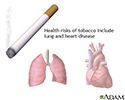Risks of tobacco
Secondhand smoke - risks; Cigarette smoking - risks; Smoking and smokeless tobacco - risks; Nicotine - risks
Knowing the serious health risks of using tobacco may help motivate you to quit. Using tobacco over a long time can increase your risk for many health problems.
Information
Tobacco is a plant. Its leaves are smoked, chewed, or sniffed for a variety of effects.
- Tobacco contains the chemical nicotine, which is an addictive substance.
- Tobacco smoke contains more than 7,000 chemicals, at least 70 of which are known to cause cancer.
- Tobacco that is not burned is called smokeless tobacco. Including nicotine, there are at least 30 chemicals in smokeless tobacco that are known to cause cancer.
HEALTH RISKS OF SMOKING OR USING SMOKELESS TOBACCO
There are many health risks from smoking and using tobacco. The more serious ones are listed below.
Heart and blood vessel problems:
- Blood clots and weakness in the walls of blood vessels in the brain, which can lead to stroke
- Blood clots in the legs, which may travel to the lungs
- Coronary artery disease, including angina and heart attack
- Temporarily increased blood pressure after smoking
- Poor blood supply to the legs
- Problems with erections because of decreased blood flow into the penis
Other health risks or problems:
- Cancer (more likely in the lung, mouth, larynx, nose and sinuses, throat, esophagus, stomach, bladder, kidney, pancreas, cervix, colon, and rectum)
- Poor wound healing after surgery
- Lung problems, such as COPD, or asthma that is harder to control
- Problems during pregnancy, such as babies born at a low birth weight, early labor, losing your baby, and cleft lip
- Decreased ability to taste and smell
- Harm to sperm, which may lead to infertility
- Loss of sight due to an increased risk of macular degeneration
- Tooth and gum diseases
- Wrinkling of the skin
Smokers who switch to smokeless tobacco instead of quitting tobacco still have health risks:
- Increased risk for cancer of the mouth, tongue, esophagus, and pancreas
- Gum problems, tooth wear, and cavities
- Worsening high blood pressure and angina
HEALTH RISKS OF SECONDHAND SMOKE
Those who are often around the smoke of others (secondhand smoke) have a higher risk for:
- Heart attack and heart disease
- Lung cancer
- Sudden and severe reactions, including of the eye, nose, throat, and lower respiratory tract
Infants and children who are often exposed to secondhand smoke are at risk for:
- Asthma flares (children with asthma who live with a smoker are much more likely to visit the emergency room)
- Infections of the mouth, throat, sinuses, ears, and lungs
- Lung damage (poor lung function)
- Sudden infant death syndrome (SIDS)
Like any addiction, quitting tobacco is difficult, especially if you are doing it alone.
- Seek support from family members, friends, and coworkers.
- Talk to your health care provider about nicotine replacement therapy and smoking cessation medicines.
- Join a smoking cessation program and you will have a much better chance of success. Such programs are offered by hospitals, health departments, community centers, and work sites.
References
Atkinson DL, Minnix J, Cinciripini PM, Karam-Hage M. Nicotine. In: Johnson BA, ed. Addiction Medicine: Science and Practice. 2nd ed. Philadelphia, PA: Elsevier; 2020:chap 23.
Brunetta PG, Kroon L. Smoking cessation. In: Broaddus VC, Ernst JD, King TE, et al, eds. Murray and Nadel's Textbook of Respiratory Medicine. 7th ed. Philadelphia, PA: Elsevier; 2022:chap 66.
George TP. Nicotine and tobacco. In: Goldman L, Schafer AI, eds. Goldman-Cecil Medicine. 26th ed. Philadelphia, PA: Elsevier; 2020:chap 29.
Gotts JE, Benowitz NL. Smoking hazards: Cigarettes, vaping, marijuana. In: Broaddus VC, Ernst JD, King TE, et al, eds. Murray and Nadel's Textbook of Respiratory Medicine. 7th ed. Philadelphia, PA: Elsevier; 2022:chap 65.
US Preventive Services Task Force; Krist AH, Davidson KW, Mangione CM, et al. Interventions for tobacco smoking cessation in adults, including pregnant persons: US Preventive Services Task Force recommendation statement. JAMA. 2021;325(3):265-279. PMID: 33464343 pubmed.ncbi.nlm.nih.gov/33464343/.
Tobacco and vascular disease - illustration
Tobacco and vascular disease
illustration
Tobacco and chemicals - illustration
Tobacco and chemicals
illustration
Tobacco and cancer - illustration
Tobacco and cancer
illustration
Tobacco health risks - illustration
Tobacco health risks
illustration
Secondhand smoke and lung cancer - illustration
Secondhand smoke and lung cancer
illustration
Respiratory cilia - illustration
Respiratory cilia
illustration
Tobacco and vascular disease - illustration
Tobacco and vascular disease
illustration
Tobacco and chemicals - illustration
Tobacco and chemicals
illustration
Tobacco and cancer - illustration
Tobacco and cancer
illustration
Tobacco health risks - illustration
Tobacco health risks
illustration
Secondhand smoke and lung cancer - illustration
Secondhand smoke and lung cancer
illustration
Respiratory cilia - illustration
Respiratory cilia
illustration
Review Date: 7/25/2022
Reviewed By: Linda J. Vorvick, MD, Clinical Professor, Department of Family Medicine, UW Medicine, School of Medicine, University of Washington, Seattle, WA. Also reviewed by David C. Dugdale, MD, Medical Director, Brenda Conaway, Editorial Director, and the A.D.A.M. Editorial team.




















